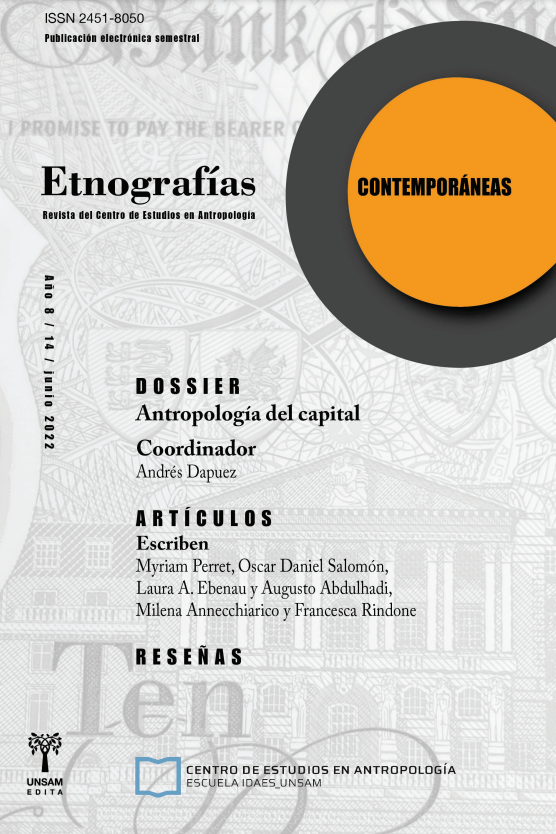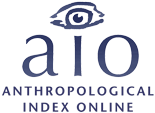All the kangaroos the dog: reflections on the interspecies relations
A dialogue with the book Amor y Enfermedad by Andrea Mastrangelo
Keywords:
visceral leishmaniasis, interspecific relationships, dog, zoonosisAbstract
The interspecific relationship between humans and dogs has given rise to an important production of analytical texts, but it has also served as a space for discussion and a bridge between disciplinary views and epistemologies. In this sense, Dr. Andrea Mastrangelo's book Love and Disease, ethnography of a zoonosis proposes the study of visceral leishmaniasis, a parasitosis shared between humans and dogs, from a posthumanist perspective. The exhaustive ethnographic analysis, which feeds the theoretical discussion, was carried out within the framework of a multidisciplinary project on the emergence of this disease, transmitted by insects, in the northwestern border of Argentina, where dogs were the discursive axis of the conflict between social and sectorial collectives. As a researcher of the aforementioned project, and as a health official who had to take decisions, the book motivated me to reflect from a biological perspective, rather than attempting an exegetical review in a foreign discipline. A counterpoint that, by recognizing a contextualized anthropocentrism, warns in relation to dogs and other «sentient beings», that even research that pretends objectivity of scientific methodology, can develop questions from preconstructed answers from the interspecific perception of the researcher.
References
Ackroyd, Peter (2001). London: The Biography. New York, Random House Inc.
Arluke, Arnold y Sax, Boria (1992). “Understanding Nazi Animal Protection and the Holocaust”, Anthrozoos A Multidisciplinary Journal of The Interactions of People & Animals, Vol. Nº 1, pp. 6-31.
Bateson, Gregory (2000). Steps to an Ecology of Mind. Chicago, University of Chicago Press.
Batt, Sara (2009). “Human attitudes towards animals in relation to species similarity to humans: a multivariate approach”, Bioscience Horizons: The International Journal of Student Research, Vol. 2, Nº 2, pp. 180–190.
Bauman, Zygmunt. y Donskis, Leonidas (2015). Ceguera moral, la pérdida de la sensibilidad en la modernidad líquida. Buenos Aires, Paidós.
Bulgakov, Mijail (2001). Corazón de Perro. México: Lectorum Eds.
Carman, María (2018). “La animalidad en cuestión: derechos, ontologías, moralidades y políticas”. Revista del Museo de Antropología, Vol. 11, Nº 1, pp. 195-208.
Castiel, Luis David; Caco, Xavier y de Moraes, Danielle Ribeiro (2016). À Procura de um Mundo Melhor: Apontamentos sobre o Cinismo em Saúde. Rio de Janeiro, Fiocruz Eds.
Cervantes, Miguel (2012), Tres Novelas Ejemplares. Madrid, Edhasa (Castalia),
Dotson, Michael y Hyatt, Eva (2008). “Animal Companions, Consumption Experiences, and the Marketing of Pets: Transcending Boundaries in the Animal-Human Distinction”, Journal of Business Research, Vol. 61, Nº 5, pp. 457-466.
Giménez-Ayala, Andrea; González-Brítez, Nilsa; Rojas de Arias, Antonieta y Ruoti, Mónica (2018). “Knowledge, attitudes, and practices regarding the leishmaniases among inhabitants from a Paraguayan district in the border area between Argentina, Brazil, and Paraguay”, Journal of Public Health, Vol.26, pp- 639-648.
GLOPID-R (2017). Integrating social science interventions in epidemic, pandemic and health emergency response Report of an informal consultation. Documento electrónico: http://www.glopid-r.org/just-released-ebola-map-on-social-science-research/ acceso 23/3/2021
Haviland, John (1974). “A Last Look at Cook’s Guugu Yimidhirr Word List”,Oceania, Vol. 44, Nº 3, pp. 216–232.
Houellebecq, Michel (2005). La posibilidad de una Isla. Madrid, Alfaguara.
Ingold, Tim (1990). “An Anthropologist Looks at Biology”, Man, New Series, Vol 25, Nº 2, pp. 208-229.
–––(2000). The Perception of the Environment: Essays on Livelihood, Dwelling and Skill. London, Routledge.
Kafka, Franz (2007). El Proceso. Madrid, Akal SA.
Lamattina, Daniela; Berrozpe, Pablo; Casas, Natalia; Moya, Sofìa Lorian; Giuliani, Magalí; Costa, Sebastián; Arrabal, Juan; Martinez, Mariela; Rivero, Marìa Romina; Salas, Martín; Humeres, Cristian Alejandro; Liotta, Domingo Javier; Meichtry, Belén. y Salomón, Oscar Daniel (2019). “Twice upon a time: the progression of canine visceral leishmaniasis in an Argentinean city”, PLoS One, Vol- 14, Nº 7, e0219395.
Lévinas, Emmanuel (1991). Ética e infinito. Madrid, Machado libros.
Lins Ribeiro, Gustavo (1989). “Descotidianizar. Extrañamiento y conciencia práctica. Un ensayo sobre la perspectiva antropológica”, Cuadernos de Antropología Social, Vol. 3: pp. 65-69.
López, Karen; Tartaglino; Lilian Catalina; Steinhorst, Ingris Iris; Santini, Marìa Soledad y Salomón, Oscar Daniel (2016). “Factores de riesgo en escenarios emergentes de leishmaniasis visceral urbana, Misiones, Argentina”, Biomédica, Vol, 36, Supl. 1, pp. 51-63.
Lueddeke, George (2018). Survival: One Health, One Planet, One Future. Londres, Routledge.
Macdonald, Donald Alister (1887). Gum boughs and wattle blooms, gathered on Australian Hills and Plains. Londres, Cassel & Company.
Manderson, Lenore y Aaby, Peter (1992). “An epidemic in the field? Rapid assessment procedures and health research”, Social Science and Medicine Vol. 35, N° 7, pp. 839-850.
March, Dana y Susser, Ezra (2006). “The eco- in eco-epidemiology‘, International Journal of Epidemiology. Vol. 35, N° 6, pp.1379-1383.
Mastrángelo, Andrea (2021). Amor y enfermedad: Etnografía de una zoonosis. San Martín, UNSAM EDITA.
Mazet, Jonna, Uhart, Marcela y Keyyu, Julius (2014). “Stakeholders in One Health”. Revue scientifique et Technique (International Office of Epizootics), Vol. 33, N° 2, pp. 443-452.
Mothu, Alain (2012) “Les Fables Canines du Cymbalum Mundi”. Bibliothèque d’Humanisme et Renaissance, Vol. 74, N° 2, pp. 297-310
Nagel, Thomas (1974). “What Is It Like to Be a Bat?”, The Philosophical Review, Vol. 83, N° 4, pp. 435-450
Neruda, Pablo (1977). Jardín de Invierno. Obra póstuma. Barcelona, Biblioteca Breve Seix Barral.
Ovidio (2003). Metamorfosis. Grupo Anaya SA, Madrid
Rabelais, François (1913). Gargantúa et Pantagruel Tome 1. Paris, Bibliothèque Larousse
Rose, Geoffrey (1985). “Sick individuals and sick populations”,. International Journal of Epidemiology, Vol. 14, N° 1, pp. 32-38.
Rowan, Andrew y Kartal Tamara (2018). “Dog Population & Dog Sheltering Trends in the United States of America”, Animals (Basel), Vol. 8, N° 5, 68 (1-20).
Salomón, Oscar Daniel (2016). “La comunicación en tiempos de dengue”, en: Investigaciones sobre mosquitos de Argentina. Mar del Plata: Universidad Nacional de Mar del Plata, pp. 324-338.
Salomón, Oscar Daniel; Pérez, Adriana; Riarte, Adelina; Casas, Natalia; Fragueiro-Frías. Victoria; Negri, Vanesa; Santini, María Soledad y Liotta, Domingo Javier (2020). “Performance of rapid tests for canine visceral leishmaniasis diagnosis in Argentina”, Medicina (B Aires), Vol. 80, N° 2, pp. 103-110.
Servais, Véronique (2018). “Anthropomorphism in Human-Animal Interactions: A Pragmatist View”, Front Psychology. Vol. 9, 2590 (1-10).
Simpson, George Gaylord (1965). The Meaning of Evolution: A Study of the History of Life and of Its Significance for Man. Calcutta, OXFORD & IBH Publising Co.
Susser, Mervyn y Susser, Ezra (1996a). “Choosing a future for epidemiology: I. Eras and paradigms”., American Journal of Public Health, Vol. 86, N° 5, pp. 668–673.
Susser, Mervin y Susser, Ezra (1996b). “Choosing a future for epidemiology: II. From black box to Chinese boxes and eco-epidemiology”, American Journal of Public Health, Vol. 86, N° 5, pp. 674–677.
Taverne, Bernard (2015). “Coordination Committee of the West Africa Ebola Social and Human Sciences Network. Preparing for Ebola outbreaks: not without the social sciences!” Global Health Promotion, Vol. 22, N° 2, pp. 5-6.
Todorov, Tzvetan (2010). La Conquista de América: el problema del otro. Madrid, Siglo XXI.
Tully, Tim (2003). “Pavlov›s dogs”. Current Biology, Vol. 13, N° 4, pp. R117-R119.
Twain; Mark (1875). “Some Learned Fables for Good Old Boys and Girls”, en: Mark Twain’s sketches, new and old. Hartford & Chicago: American Publishing Company, pp.126-148) (traducción del autor).
–––(1904). A dog’s tale. New York: Harper & Brothers.
WHO (2004). Scientific working group on Leishmaniasis Meeting report. 2-4 February 2004, Geneva, Switzerland TDR/SWG/04, documento electrónico: https://www.who.int/tdr/publications/tdr-research-publications/swg-reportleishmaniasis/ en/, acceso 23/3/2021
WHO-OIE-FAO (2019). Taking a Multisectoral, One Health Approach: A Tripartite Guide to Addressing Zoonotic Diseases in Countries, documento electronico: https://apps.who.int/iris/handle/325620, acceso 23/3/2021
























